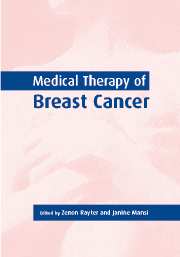Book contents
- Frontmatter
- Contents
- List of contributors
- 1 History of breast cancer therapy
- 2 Chemoprevention of breast cancer
- 3 Familial breast cancer
- 4 Hormone replacement therapy and breast cancer
- 5 Screening for breast cancer
- 6 The management of in situ breast cancer
- 7 Adjuvant systemic therapy
- 8 Adjuvant radiotherapy in the management of breast cancer
- 9 Predictors of response and resistance to medical therapy
- 9a Cell kinetic parameters and response to therapy
- 9b Predictors of response and resistance to medical therapy: endocrine therapy
- 9c Predictors of response and resistance to medical therapy: chemotherapy
- 10 Primary medical therapy in breast cancer
- 11 Medical therapy of advanced disease
- 12 Experimental approaches
- 13 The place of bisphosphonates in the management of breast cancer
- 14 Palliative care in breast cancer
- Index
9c - Predictors of response and resistance to medical therapy: chemotherapy
Published online by Cambridge University Press: 06 January 2010
- Frontmatter
- Contents
- List of contributors
- 1 History of breast cancer therapy
- 2 Chemoprevention of breast cancer
- 3 Familial breast cancer
- 4 Hormone replacement therapy and breast cancer
- 5 Screening for breast cancer
- 6 The management of in situ breast cancer
- 7 Adjuvant systemic therapy
- 8 Adjuvant radiotherapy in the management of breast cancer
- 9 Predictors of response and resistance to medical therapy
- 9a Cell kinetic parameters and response to therapy
- 9b Predictors of response and resistance to medical therapy: endocrine therapy
- 9c Predictors of response and resistance to medical therapy: chemotherapy
- 10 Primary medical therapy in breast cancer
- 11 Medical therapy of advanced disease
- 12 Experimental approaches
- 13 The place of bisphosphonates in the management of breast cancer
- 14 Palliative care in breast cancer
- Index
Summary
Introduction
Resistance to chemotherapy invariably occurs in breast cancer patients being treated for metastatic disease. As with hormonal therapy, resistance may be either ‘intrinsic’, manifest as a failure to respond to initial therapy, or ‘acquired’, seen as progression after a variable length of time in patients who initially respond to cytotoxic therapy. In the adjuvant setting resistance to chemotherapy is inferred by rapid relapse following completion of therapy. In vitro models have established that cancer cells exhibit varying degrees of intrinsic drug-specific resistance, but may also acquire the same phenotype following long-term exposure to a given agent. Many of the established mechanisms of resistance are associated with genetic abnormalities such as activation of dominantly active oncogenes, or loss of tumour suppressor genes. Both patterns of intrinsic and acquired resistance are consistent with a model of cumulative genetic change during the development and progression of breast cancer.
Although many of the mechanisms involved in chemoresistance have been investigated extensively in vitro, other factors such as systemic drug metabolism and bioavailability may influence the likelihood of tumour response/resistance in vivo. Clinical studies have been used to verify whether a given genetic or biochemical change observed in experimental studies of drug resistance is relevant to clinical practice. There are several limitations in this approach when studying biological markers of resistance, not least the methodologic problems in analyzing clinical specimens (for example, protein vs. RNA analysis, type of antibody used, tissue fixation) and sampling errors due to heterogeneous expression within human tumours.
- Type
- Chapter
- Information
- Medical Therapy of Breast Cancer , pp. 246 - 263Publisher: Cambridge University PressPrint publication year: 2003



